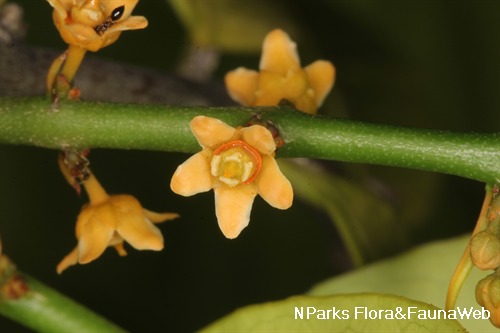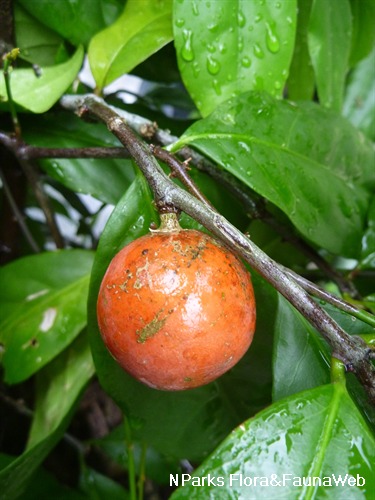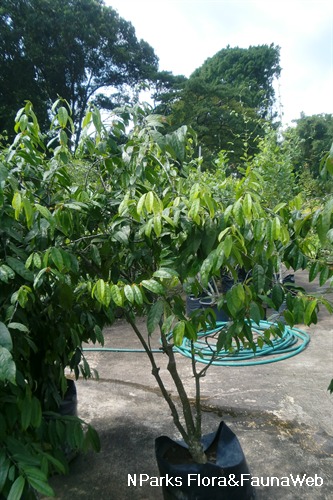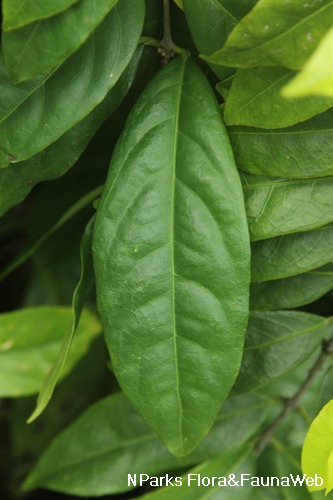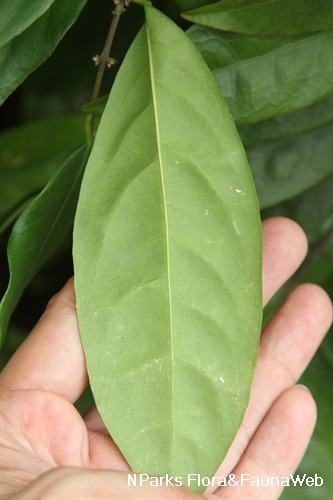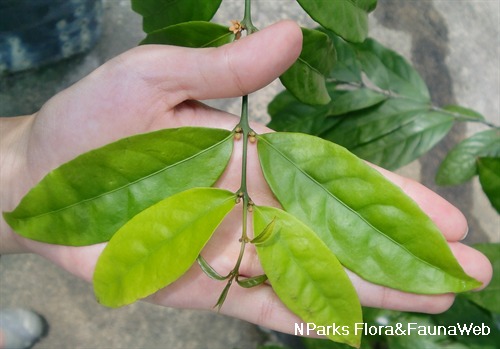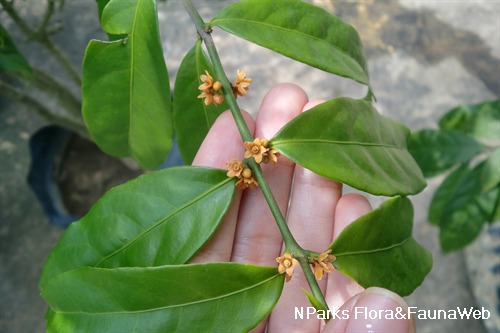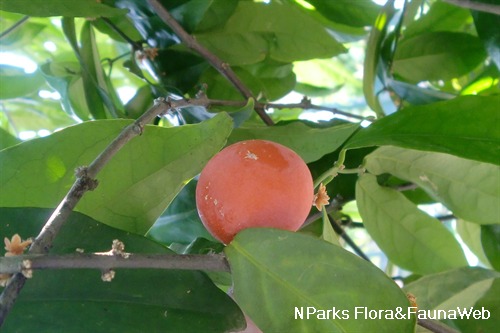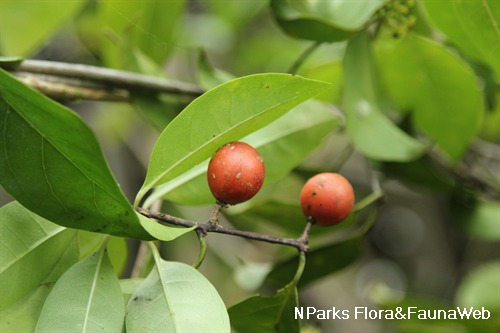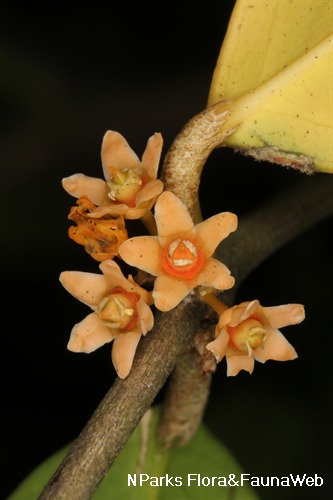
Back
Salacia miqueliana Loes.
| Family Name: | Celastraceae |
| Synonyms: | Salacia flavescens Kurz, Salacia macrophylla Blume |
| Common Name: | Hempedal Itek, Nasi Sejuk, Sedang |
Name
Classifications and Characteristics
| Plant Division | Angiosperms (Flowering Seed Plants) (Dicotyledon) |
|---|---|
| Plant Growth Form | Climber |
| Lifespan (in Singapore) | Perennial |
| Mode of Nutrition | Autotrophic |
| Plant Shape | Irregular |
Biogeography
| Native Distribution | India, Myanmar, Thailand, Indochina, Sumatra, Peninsular Malaysia, Singapore, Borneo, Java, Sulawesi, and Lesser Sunda Islands |
|---|---|
| Native Habitat | Terrestrial (Primary Rainforest, Inland Cliff, Mountain, Coastal Forest, Freshwater Swamp Forest) |
| Preferred Climate Zone | Tropical, Sub-Tropical / Monsoonal |
| Local Conservation Status | Native to Singapore (Vulnerable (VU)) |
Description and Ethnobotany
| Growth Form | It is a woody climber, or sometimes a shrub or creeping shrub. |
|---|---|
| Foliage | The dark green leaves are arranged in opposite pairs along the stem. Its slightly leathery leaf blades are highly variable in shape, and 7.5–34 by 4.5–13.5 cm. |
| Flowers | The flowers are small and originate from the leaf axils in clusters. The flowers have 5 sepals and 5 petals and are orange in colour. |
| Fruit | Its orange or red fruits are broadly ellipsoid or almost spherical, and 5.5–6.5 by 5–5.5 cm. Each fruit contains 3 or more white, ellipsoid seeds that are 2–3 by 1–2 cm. |
| Habitat | It grows in lowland forests, near the coast, occasionally in freshwater swamps, or on limestone rocks, up to 1,200 m altitude. It occurs locally in Nee Soon Swamp Forest, in the vicinity of Upper Pierce Reservoir, and the Mandai Road area. |
| Associated Fauna | Its flowers are insect-pollinated. Its fruits are probably eaten by small mammals. |
| Cultivation | It can be propagated by seed. |
| Etymology | Latin Salacia, from Greek mythology, the wife of Neptune, goddess of the sea; Latin miqueliana, commemorating F.A.W Miquel (1811-1871), a German physician who became the director of the Leiden Herbarium (Netherlands). |
| Ethnobotanical Uses | Edible Plant Parts : Edible Fruits Food (Fruit or Vegetable): The pulp of its fruits is eaten. |
Landscaping Features
| Landscaping | It is suitable for growing in parks and gardens as a shrub or over pergolas and trellises. |
|---|---|
| Desirable Plant Features | Ornamental Fruits |
| Landscape Uses | General, Parks & Gardens, Small Gardens, Coastal, Trellis / Arbour / Pergola |
Fauna, Pollination and Dispersal
| Pollination Method(s) | Biotic (Fauna) |
|---|---|
| Seed or Spore Dispersal | Biotic (Fauna) |
Plant Care and Propagation
| Light Preference | Full Sun, Semi-Shade |
|---|---|
| Water Preference | Moderate Water |
| Plant Growth Rate | Moderate |
| Rootzone Tolerance | Moist Soils, Well-Drained Soils, Fertile Loamy Soils |
| Propagation Method | Seed |
Foliar
| Foliage Retention | Evergreen |
|---|---|
| Mature Foliage Colour(s) | Green |
| Mature Foliage Texture(s) | Leathery |
| Foliar Type | Simple / Unifoliate |
| Foliar Arrangement Along Stem | Opposite |
| Foliar Attachment to Stem | Petiolate |
| Foliar Shape(s) | Non-Palm Foliage |
| Foliar Venation | Pinnate / Net |
| Foliar Margin | Entire |
Floral (Angiosperm)
| Flower & Plant Sexuality | Bisexual Flowers |
| Flower Colour(s) | Orange |
|---|---|
| Flower Grouping | Cluster / Inflorescence |
| Flower Location | Axillary |
| Flower Symmetry | Radial |
| Individual Flower Shape | Stellate / Star-shaped |
Fruit, Seed and Spore
| Mature Fruit Colour(s) | Orange, Red |
|---|---|
| Mature Fruit Texture(s) | Smooth |
| Fruit Classification | Simple Fruit |
| Fruit Type |
Image Repository
Others
| Master ID | 31401 |
|---|---|
| Species ID | 5798 |
| Flora Disclaimer | The information in this website has been compiled from reliable sources, such as reference works on medicinal plants. It is not a substitute for medical advice or treatment and NParks does not purport to provide any medical advice. Readers should always consult his/her physician before using or consuming a plant for medicinal purposes. |

